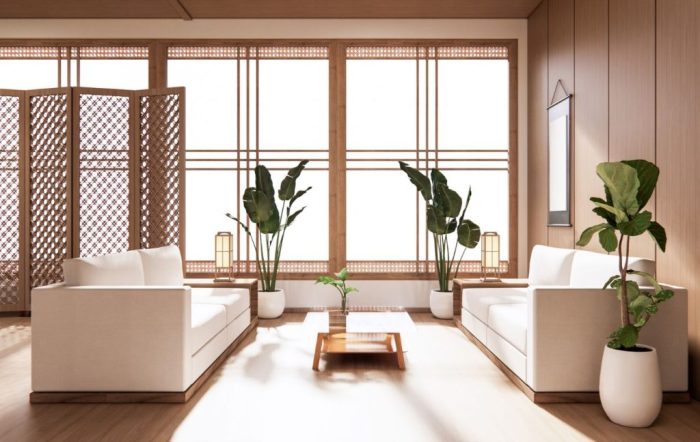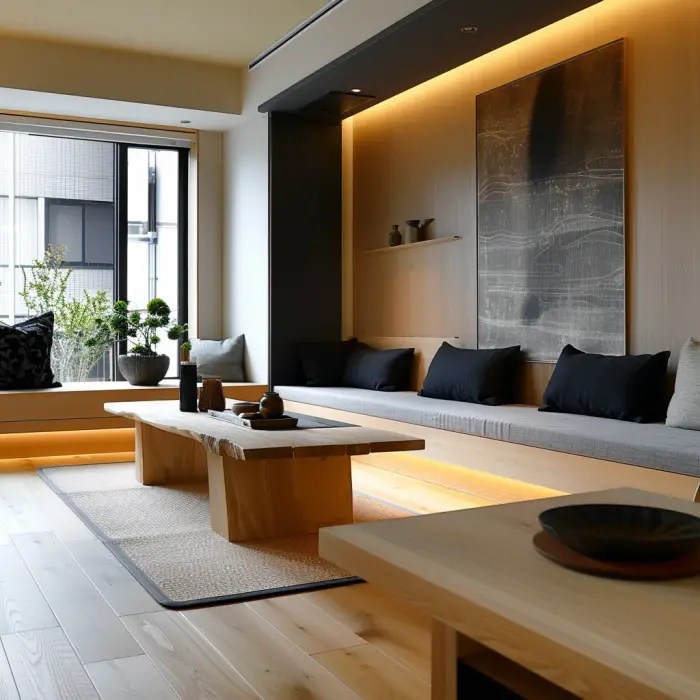Exploring Modern Japanese Interior Design: A Fusion of Tradition and Minimalism
Delving into modern Japanese interior design, this introduction immerses readers in a unique and compelling narrative. From the incorporation of traditional Japanese design elements to the balance between minimalism and functionality, this topic offers a fascinating insight into creating harmonious living spaces.
As we delve deeper, we will uncover the key characteristics, color palette, furniture layout, and decorative elements that define modern Japanese interior design.
Overview of Modern Japanese Interior Design

In modern Japanese interior design, the key characteristics often revolve around simplicity, minimalism, and a deep connection to nature. Traditional Japanese design elements are seamlessly incorporated into modern interiors to create a harmonious and serene atmosphere.
Incorporation of Traditional Japanese Design Elements
- Shoji screens: These traditional Japanese sliding doors are often used in modern interiors to divide spaces while allowing natural light to filter through.
- Tatami mats: These traditional straw mats are still popular in modern Japanese interior design, adding a touch of authenticity and comfort to the space.
- Fusuma doors: These sliding doors with paper panels are used to create versatile and adaptable room layouts in modern interiors.
Balance of Minimalism and Functionality
In modern Japanese interior design, there is a delicate balance between minimalism and functionality. Spaces are kept clutter-free and simple, with an emphasis on clean lines and uncluttered surfaces. At the same time, there is a strong focus on functionality, ensuring that every element in the space serves a purpose and enhances the overall functionality of the room.
Use of Natural Materials
- Wood: One of the most prominent materials used in modern Japanese interiors, wood brings warmth and a sense of nature into the space.
- Bamboo: Lightweight and sustainable, bamboo is often used for flooring, furniture, and decor elements in modern Japanese interiors.
- Stone: Natural stone like granite, marble, or slate is used for countertops, flooring, and accent walls, adding a touch of elegance and tranquility to the space.
Color Palette and Materials
When it comes to modern Japanese interior design, the color palette and materials play a crucial role in creating a peaceful and harmonious space that reflects the essence of Japanese aesthetics.
Natural Light and Color Choices
In modern Japanese interiors, the color palette often consists of neutral tones such as white, beige, grey, and earthy colors like brown and green. These colors are chosen to create a sense of serenity and simplicity, in line with traditional Japanese design principles.
Sliding Doors and Screens
One of the distinctive features of modern Japanese interior design is the use of sliding doors known as fusuma and shoji. Fusuma are opaque doors made of wooden frames covered with thick paper, while shoji are sliding screens made of wooden lattice frames with translucent paper.
These doors and screens allow natural light to filter through, creating a soft and diffused light that enhances the overall ambiance of the space.
Textures and Finishes
Incorporating textures and finishes like tatami mats, rice paper, and bamboo is essential in modern Japanese interior design. Tatami mats are traditional straw mats that add warmth and softness to the floor, while rice paper is used for shoji screens to create a delicate and luminous effect.
Bamboo is often used for furniture and decor accents, adding a touch of nature and sustainability to the space.
Furniture and Layout
In modern Japanese interior design, the choice of furniture and its layout plays a crucial role in creating a harmonious and functional space.
Traditional vs. Modern Furniture
Traditional Japanese furniture, such as tatami mats, low tables, and sliding doors, has been adapted in modern interiors with a touch of minimalism and sleek design. Modern adaptations often combine traditional elements with contemporary materials and finishes to create a unique blend of old and new.
Multifunctional Furniture
Examples of multifunctional furniture pieces commonly found in modern Japanese interiors include futons that double as seating during the day, storage beds with hidden compartments, and sliding panels that can be used to divide spaces or conceal storage areas. These pieces are designed to maximize space and functionality in a minimalist way
'Ma' and Furniture Arrangement
The concept of 'ma,' or negative space, is essential in Japanese design and influences furniture arrangement. By incorporating 'ma,' designers create a sense of balance and harmony in the space, allowing for a peaceful and uncluttered environment. Furniture is often placed strategically to create open pathways and promote a sense of flow within the room.
Room Layout and Functionality
The layout of rooms in modern Japanese interiors is carefully considered to enhance both aesthetic appeal and functionality. Rooms are often divided by sliding doors or screens that can be opened to create larger spaces for gatherings or closed for privacy.
Furniture placement is thoughtfully arranged to optimize natural light, promote ventilation, and create a sense of tranquility throughout the space.
Decorative Elements and Accents

In modern Japanese interior design, decorative elements and accents play a crucial role in creating a serene and harmonious atmosphere. These elements often reflect the principles of simplicity, nature, and asymmetry that are inherent to Japanese aesthetics.
Natural Elements
Incorporating natural elements such as bonsai trees, ikebana flower arrangements, and rock gardens is a common practice in modern Japanese interiors. Bonsai trees symbolize harmony, balance, and tranquility, while ikebana arrangements emphasize minimalism and the beauty of imperfection. Rock gardens, known as karesansui, evoke a sense of Zen and contemplation.
Simplicity and Asymmetry
Decorative accents like artwork, pottery, and textiles in modern Japanese interiors often highlight simplicity and asymmetry. This design approach reflects the Japanese concept of wabi-sabi, finding beauty in imperfection and transience. Asymmetrical placement of artworks and carefully chosen pottery pieces add visual interest and a sense of balance to the space.
Indoor Plants
Indoor plants play a vital role in modern Japanese interior design, bringing life and a sense of tranquility to the space. Plants such as bamboo, bonsai, and peace lilies are commonly used to enhance the connection with nature indoors. Their presence not only purifies the air but also contributes to a calming and peaceful ambiance.
Traditional Japanese Art Forms
Traditional Japanese art forms like calligraphy and origami are often incorporated into contemporary interior design to add cultural depth and aesthetic appeal. Calligraphy, known as shodo, adds a sense of elegance and sophistication to the walls, while origami creations bring a touch of playfulness and creativity to the decor.
End of Discussion
In conclusion, modern Japanese interior design seamlessly blends the old with the new, creating serene and functional spaces that invite tranquility and peace. Embracing natural materials, traditional elements, and a minimalist aesthetic, this design style offers a timeless appeal for those seeking a harmonious living environment.
Expert Answers
How are traditional Japanese design elements incorporated into modern interiors?
Traditional Japanese design elements such as shoji screens, tatami mats, and natural materials like wood and bamboo are often used in modern interiors to create a sense of harmony and simplicity.
What is the significance of 'ma' (negative space) in Japanese interior design?
'Ma' or negative space plays a crucial role in Japanese design by allowing for a sense of openness and balance within a space, emphasizing the importance of what is not there rather than what is.
How do indoor plants contribute to modern Japanese spaces?
Indoor plants in modern Japanese interiors bring life, a touch of nature, and a sense of tranquility to the space, enhancing the overall ambiance and connection to the outdoors.